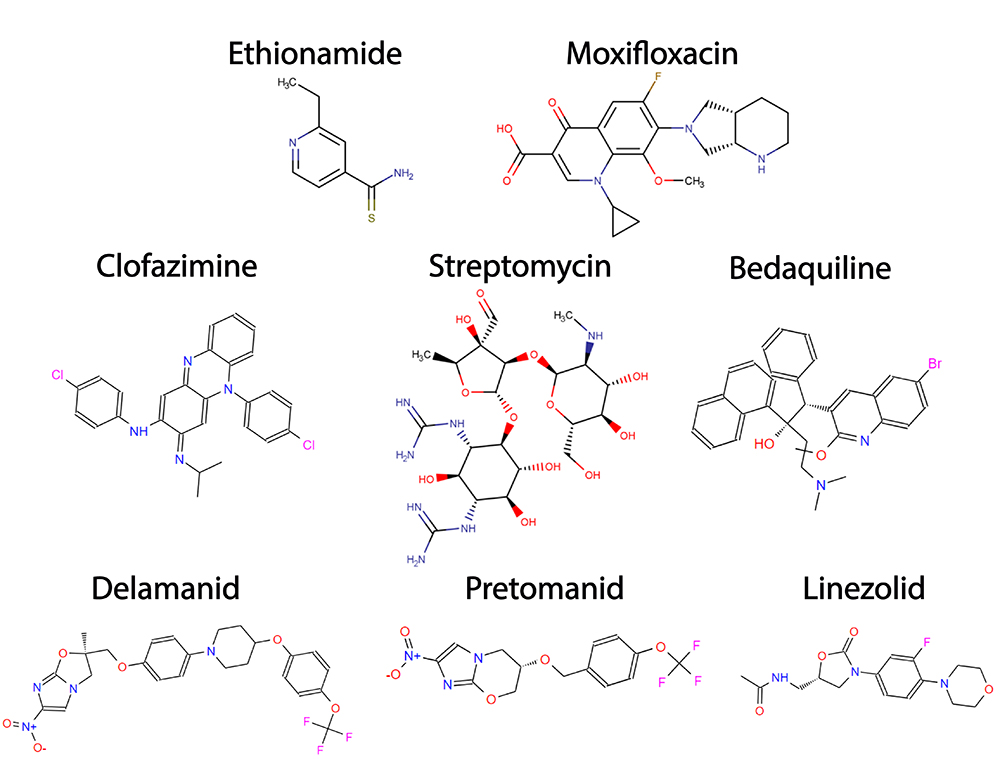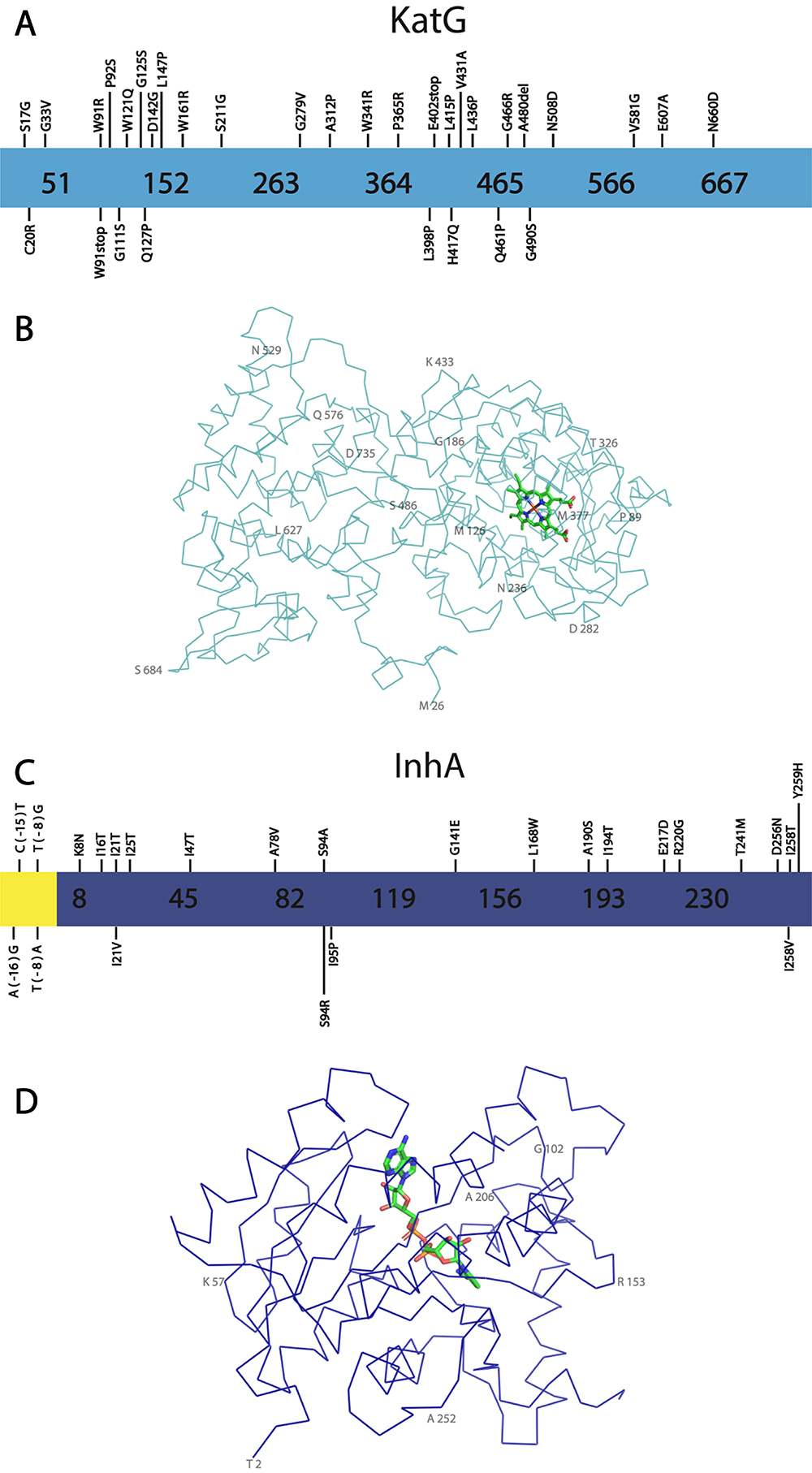Figure 1 -
First-line drugs used in tuberculosis treatment. Structures for first-line drugs used in tuberculosis treatment, Isoniazid, Pyrazinamide, Rifampicin and Ethambutol. Structures were drawn using Marvin software (Cherinka et al., 2019Cherinka B, Andrews BH, Sánchez-Gallego J, Brownstein J, Argudo-Fernández M, Blanton M, Bundy K, Jones A, Masters K, Law DR et al. (2019) Marvin: A tool kit for streamlined access and visualization of the SDSS-IV MaNGA data set. Astron J 158:74.).
Figure 2 -
Second-line drugs used in tuberculosis treatment. Structures for some second-line drugs used in tuberculosis treatment, Ethionamide, Moxifloxacin (Fluoroquinolone), Clofazimine, Streptomycin (injectable aminoglycoside), Bedaquiline, Delamanid, Pretomanid and Linezolid Structures were drawn using Marvin software (Cherinka et al., 2019Li K, Yang Z, Gu J, Luo M, Deng J and Chen Y (2021) Characterization of pncA Mutations and Prediction of PZA Resistance in Mycobacterium tuberculosis Clinical Isolates From Chongqing, China. Front Microbiol 11:594171.).
Figure 3 -
InhA inhibition by INH-NAD adduct. Mechanism of action of InhA and inhibition by INH. KatG activates INH to produce the adduct INH-NAD adduct, which is formed through a reaction with NADH. InhA is inhibited by INH-NAD adduct, which blocks the fatty acid elongation catalyzed by the FAS-II system. Adapted from Vilchèze and Jacobs 2007Vilchèze C and Jacobs WR (2007) The mechanism of isoniazid killing: Clarity through the scope of genetics. Annu Rev Microbiol 61:35-50..
Figure 4 -
Structure and key mutations for KatG and InhA, proteins involved in INH resistance. A - Representation of KatG primary sequence is shown light blue, showing novel mutations. B - Representation of KatG structure. The contours of Cα are shown in light blue, while the Heme group is shown with carbon atoms in light green. Some residues are numbered in 50% opacity for better visualization. The KatG structure was obtained from PDB entry 2CCA (Zhao et al., 2006Zhao X, Yu H, Yu S, Wang F, Sacchettini JC and Magliozzo RS (2006) Hydrogen peroxide-mediated isoniazid activation catalyzed by Mycobacterium tuberculosis catalase-peroxidase (KatG) and its S315T mutant. Biochemistry 45:4131-4140.) and visualized using the software PyMOL (Schrödinger, 2015Sambandamurthy VK, Wang X, Chen B, Russell RG, Derrick S, Collins FM, Morris SL and Jacobs WR (2002) A pantothenate auxotroph of Mycobacterium tuberculosis is highly attenuated and protects mice against tuberculosis. Nat Med 8:1171-1174.). C - Representation of InhA sequence in dark blue, showing the most significant mutations. The InhA promoter region is shown in yellow. D - Representation of the structure. The contours of Cα are shown in dark blue while the NADH is shown with carbon atoms in light green. Some residues are numbered in 50% opacity for better visualization. The structure was obtained from PDB entry 4TRN (Chollet et al., 2015Chollet A, Mourey L, Lherbet C, Delbot A, Julien S, Baltas M, Bernadou J, Pratviel G, Maveyraud L and Bernardes-Génisson V (2015) Crystal structure of the enoyl-ACP reductase of Mycobacterium tuberculosis (InhA) in the apo-form and in complex with the active metabolite of isoniazid pre-formed by a biomimetic approach. J Struct Biol 190:328-337.) and the figure was prepared using the software PyMOL (Schrödinger, 2015Schrödinger LLC (2015) The {PyMOL} Molecular Graphics System. Version 1.8. ).
Figure 5 -
Structure and key mutations for β-subunit of RNAP encoded by rpoB gene, the main target of RIF and the most reported protein in RIF resistance. A - Representation of β-subunit of RNAP primary sequence in orange, showing the most relevant mutations. Substitutions are shown in black, while insertions and deletions are shown in red. B - The β-subunit of RNAP structure. The representation in orange shows the Cα contours while RIF is shown with carbon atoms in light green. The β-subunit of RNAPR encoded by rpoB was obtained from PDB entry 5UHD (Lin et al., 2017Lin W, Mandal S, Degen D, Liu Y, Ebright YW, Li S, Feng Y, Zhang Y, Mandal S, Jiang Y et al. (2017) Structural basis of Mycobacterium tuberculosis transcription and transcription inhibition. Mol Cell 66:169-179.e8.) and the figure was prepared using the software PyMOL (Schrödinger, 2015Sambandamurthy VK, Wang X, Chen B, Russell RG, Derrick S, Collins FM, Morris SL and Jacobs WR (2002) A pantothenate auxotroph of Mycobacterium tuberculosis is highly attenuated and protects mice against tuberculosis. Nat Med 8:1171-1174.). Some residues are numbered in 50% opacity for better visualization.
Figure 6 -
Structure and relevant mutations for PncA and PanD, enzymes involved in PZA resistance. A - Representation of the PncA primary sequence in light green, showing key mutations. Substitutions are shown in black, while insertions and deletions are sown in red. The pncA promoter region is shown in yellow. B - Structure of PncA. The contours of Cα are shown in light green. PncA structure was obtained from PDB entry 3PL1 (Petrella et al., 2011Petrella S, Gelus-Ziental N, Maudry A, Laurans C, Boudjelloul R and Sougakoff W (2011) Crystal structure of the pyrazinamidase of Mycobacterium tuberculosis: Insights into natural and acquired resistance to pyrazinamide. PLoS One 6:e15785.) and the figure was prepared using the software PyMOL (Schrödinger, 2015Sambandamurthy VK, Wang X, Chen B, Russell RG, Derrick S, Collins FM, Morris SL and Jacobs WR (2002) A pantothenate auxotroph of Mycobacterium tuberculosis is highly attenuated and protects mice against tuberculosis. Nat Med 8:1171-1174.). Some residues are numbered in 50% opacity for better visualization. C - Representation of the PanD primary sequence is shown in dark green, highlighting the most significant mutations. D - PanD Structure. The contours of Cα are shown in dark green, while PZA is shown with carbon atoms in light green. The PanD Structure was obtained from PDB entry 6OZ8 (Sun et al., 2020Sun Q, Xiao TY, Liu HC, Zhao XQ, Liu ZG, Li YN, Zeng H, Zhao LL and Wan KL (2018) Mutations within embCAB are associated with variable level of ethambutol resistance in Mycobacterium tuberculosis isolates from China. Antimicrob Agents Chemother 62:e01279-17.) and the figure was prepared using the software PyMOL (Schrödinger, 2015). A number of residues are numbered in 50% opacity for better visualization.
Figure 7 -
Structure and key mutations involved in the embCAB operon and their proteins, which are involved with EMB resistance. A - Representation of embCAB operon and the position of mutations involved in the resistance to EMB. The EmbC, EmbA and EmbB sequences are represented in purple, red and pink, respectively, showing the mutations described herein. The intergenic spaces between the gene encoding regions are shown in yellow. B - EmbB Structure. The Cα contours are shown in pink. EmbB structure was obtained from PDB entry 7BVF (Zhang et al., 2020Zhang L, Zhao Y, Gao Y, Wu L, Gao R, Zhang Q, Wang Y, Wu C, Wu F, Gurcha SS et al. (2020) Structures of cell wall arabinosyltransferases with the anti-tuberculosis drug ethambutol. Science 368:1211-1219.) and the figure was prepared using the software PyMOL (Schrödinger, 2015Sambandamurthy VK, Wang X, Chen B, Russell RG, Derrick S, Collins FM, Morris SL and Jacobs WR (2002) A pantothenate auxotroph of Mycobacterium tuberculosis is highly attenuated and protects mice against tuberculosis. Nat Med 8:1171-1174.). A number of residues are numbered in 50% opacity for better visualization.

 Thumbnail
Thumbnail
 Thumbnail
Thumbnail
 Thumbnail
Thumbnail
 Thumbnail
Thumbnail
 Thumbnail
Thumbnail
 Thumbnail
Thumbnail
 Thumbnail
Thumbnail






